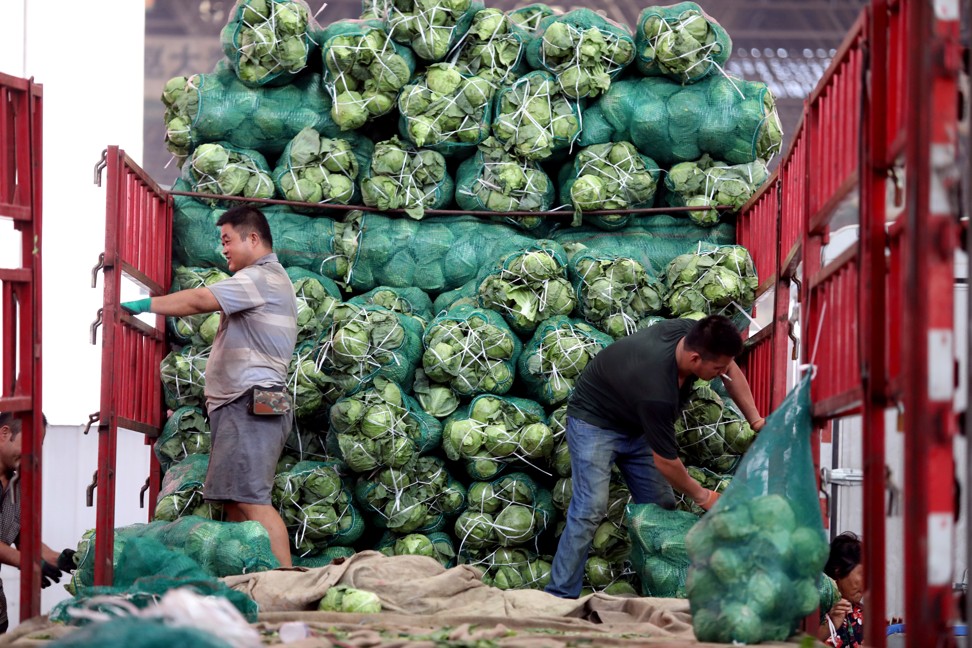
China’s inflation hits six-month high, but trade war not to blame
Heavy rains, swine flu fuel higher food prices as consumer price index accelerates to 2.3 per cent in August
China’s consumer inflation rose to a six-month high last month due to higher food prices brought on by bad weather and an outbreak of swine flu, but the figures showed little direct impact from the trade war with the United States.
A further sharp rise was unlikely unless the swine flu situation worsened considerably, analysts said.
The national consumer price index accelerated to 2.3 per cent in August from 2.1 per cent in July, the National Bureau of Statistics said on Monday.
Food prices were the main driver of the increase, rising 1.7 per cent from a year earlier, and much faster than the 0.5 per cent gain a month earlier. Vegetable prices rose 4.3 per cent as supplies were disrupted by the effect of heavy rains in Liaoning and Jilin provinces, and severe flooding in Shandong province.
Rising oil prices continued to put upwards pressure on the index in August. Petrol prices rose 19.8 per cent from a year earlier while diesel fuel prices jumped 22 per cent, as a weaker yuan raised the price of US dollar-denominated oil and oil product imports.
Chinese core inflation, which excludes volatile food and energy prices, increased 2 per cent in August, 0.1 percentage points higher than July, government data showed.
Why China cannot rely on consumers to spend their way out of the trade war
The impact of higher food prices is better seen in the measure of prices compared to the previous month. The consumer price index rose 0.7 per cent from July, the largest rise since February, driven up by a 9 per cent rise in vegetable prices and a 6.5 per cent gain in the price of pork.
China has reported outbreaks of African swine fever in eight provinces since August, leading to the culling of tens of thousands of infected animals that has disrupted the supply of pork, the staple meat on Chinese dinner tables.
While pork prices rose sharply in August, they were still 4.9 per cent lower than a year ago, the statistics bureau said.
Despite the August increase, consumer inflation remains well within the government’s target of a 3 per cent rise for the year, though an unexpected spike could create a fresh economic headache for Beijing even as it is busy trying to stabilise slowing growth at home and managing a trade war with the US.
American shoppers set to pay higher price than Chinese for trade war
Liu Xuezhi, an economist at Bank of Communications, said the current increase of consumer prices was largely due to higher food prices, which rose in part due to seasonal factors.
“There were some worries in markets over imported inflation, but it was not obvious in the August data and not a major cause [of the rise during the month],” he said.

The impact of the US tariffs on prices had not been as severe as many anticipated, Liu said.
“A vast majority of raw materials are [imported] from emerging economies. Even for soybeans, which China used to import a lot of from the US, its influence on downstream users will be limited,” he said.
China and the US have imposed 25 per cent tariffs on US$50 billion worth of imports from each other. The US is expected to escalate the tension by imposing tariffs on US$200 billion worth of Chinese products in coming days, with China threatening to retaliate against US$60 billion worth of US goods.
China slaughters 38,000 pigs to stop spread of swine fever
Julian Evans-Pritchard, senior China economist at Capital Economics, said that a significant further pick-up in inflation was unlikely.
“Inflation a little over 2 per cent is hardly alarming,” he wrote in a research note. “Unless the ongoing outbreak of swine flu becomes much more widespread, the impact on food price inflation should be fairly contained.”
China’s wholesale inflation cooled in August, the statistics bureau said, possibly signalling downward price pressures on the consumer level in coming months.
The producer price index, a gauge of prices at the factory gate, rose 4.1 per cent in August from a year earlier, slowing from a 4.6 per cent increase in July, the statistics agency said.


